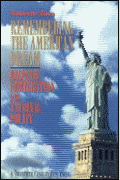Introduction
Professors Lawrence Baum and Stephen Legomsky have documented the shortcomings of the nation’s immigration adjudication system as revealed in popular and academic articles, government and interest group reports, pleas by immigration judges, exasperated criticisms by federal appellate judges, and their own examination of original data and other sources.
The resource-starved U.S. immigration removal adjudication system’s sometimes shabby and uneven treatment of immigrants sends to foreign countries some individuals who are convinced that they received a level of justice that was no better than they would have received from autocratic bureaucracies in their home countries. The system permits others to stay here despite dubious claims to that right.
Removal adjudication is part of the slot machine that is U.S. immigration enforcement, which abides the unauthorized presence of ten to twelve million individuals, while scooping up a fraction of them for criminal prosecution or removal proceedings. Those targeted for removal include some who have committed serious crimes but also plenty who simply had the misfortune of working for employers with a high percentage of illegal workers. Judge Jon Newman of the Second Circuit took note of this uneven treatment in recommending that the Department of Homeland Security (DHS) consider permitting a particular immigrant whom an immigration judge had ordered removed “to remain here along with the millions of others who are not removed despite their lack of a lawful status.”[i]
Professor Legomsky proposes a variety of changes to this system, including a more independent first-instance judiciary and a specialized federal appellate court.[ii] Professor Baum analyzes how specialization affects judging generally and might affect removal litigation.[iii] In so doing, he sheds some valuable light on how the Legomsky specialized appellate court might operate compared to alternative proposals for restructuring removal adjudication appeals. Both articles are admirable for their analysis, and although chances are slim for moving immigration adjudication outside the purview of the Department of Justice (DOJ), it is beneficial to churn ideas and be ready should an opportunity arise. After explaining my pessimism about structural change, I discuss Legomsky’s proposal in Part I, drawing on Baum’s insights on specialized courts. Then, in Part II, I outline a new (and fairly undeveloped) approach to improving immigration court performance without major structural change but with a changed DOJ outlook on immigration court oversight and management.
Effecting major legislative changes—such as a restructured removal adjudication system—would be a hard slog even with substantial legislative majorities in a period of unified government. It would be even harder in a divided government or one with small legislative majorities under pressure to reduce federal spending. In fact, the demand for tougher enforcement of laws on the books could lead to pressure, not to make removal adjudication more accommodating to aliens, but just the opposite—that is, an Ashcroft rather than a Reno mentality. Immigration hard-liners can point to reports of disparate asylum adjudication as proof that the adjudication system grants asylum to those who do not deserve it. Professor Legomsky reasons, correctly I think, that the 2002 changes at the Board of Immigration Appeals (BIA)—a reduction in size and procedural cuts linked to that reduction—produced more BIA decisions unfavorable to immigrants.[iv] Legislators might decide that keeping the immigration courts resource-starved will reduce the number of decisions in which immigrants prevail.
Perhaps the best source of optimism for restructuring and better resourcing the adjudication system is a shared concern that it may be sending bona fide refugees-in-fact to countries with human rights records deplored across the political spectrum. Although most removal proceedings completed in 2008 involved Latin Americans, only two Latin American countries made the top ten list of nationalities receiving asylum in 2008. China heads the list, which included some nationalities that barely made or were not even among the top twenty-five in completed removal proceedings—aliens from Iraq, Albania, Ethiopia, Guinea, and Russia.[v] These facts, though, have not produced much pressure for major change so far.
[i]
Rotimi v. Holder, 577 F.3d 133, 139 (2d Cir. 2009) (Newman, J., concurring).
[ii]
See Stephen H. Legomsky, Restructuring Immigration Adjudication, 59 DUKE L.J. 1635 (2010).
[iii]
See Lawrence Baum, Judicial Specialization and the Adjudication of Immigration Cases, 59 DUKE L.J. 1501 (2010).
[iv]
Legomsky, supra note 2, at 1659.
[v]
See EXECUTIVE OFFICE FOR IMMIGRATION REVIEW, U.S. DEP’T OF JUSTICE, FY 2008 STATISTICAL YEAR BOOK, at E1 fig.6, E2 tbl.5, J1 fig.15, J2 tbl.7 (2009) [hereinafter EOIR], available at
http://www.justice.gov/eoir/statspub/fy08syb.pdf
.










Commentary
U.S. Immigration Adjudication System: Practical Impediments to Structural Reform and the Promise of Third Branch Analytic Methods
April 30, 2010